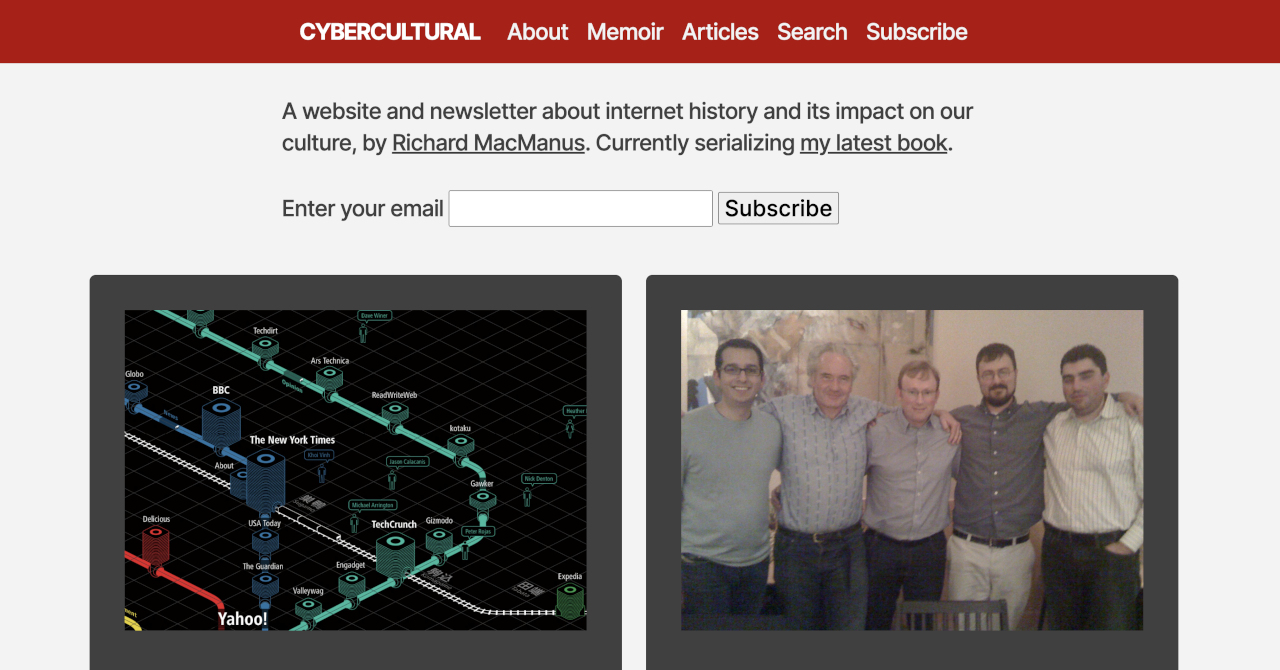Today I’ve gone live with a new website and email newsletter platform for Cybercultural, my tech history newsletter that I started on Substack in 2019. What pushed me to migrate off Substack is its stance on hate content, which I personally object to. But over the past several months, I’ve also been pondering how to reduce my reliance on centralized tech platforms — and ultimately that’s what drove my decision-making on what to migrate to.
In short, I wanted a solution that was based on the open web and that was entirely under my control. Not coincidentally, I quit X/Twitter (a centralized platform) for good in November last year and made my new social media home Mastodon (an open source, decentralized product built on a W3C open web standard). I wanted to make a similar move for my newsletter: from centralized platform to open web, from corporate to indie, from being controlled to taking back control.
My New Solution: Eleventy + Buttondown
When you go to Cybercultural.com now, you will see a website built using the static site generator Eleventy. I am using Visual Studio Code to manage the files and code, which are stored both locally and on my GitHub account. The site is deployed using Netlify and I manage my domain using Namecheap. I’m going to use the Bear app, another great indie product, to write my posts (it has a nifty WYSIWYG Markdown editor).
The key thing here is that the master files for all my Cybercultural articles will be in the Eleventy website, and ultimately live on my laptop. So they’re completely under my control, and not living on Substack anymore. Incidentally, this is similar to how Radio Userland and Movable Type used to work — the two main blogging platforms I used in the first decade of the 2000s, when I ran ReadWriteWeb. So I feel comfortable using this publishing paradigm; and for a fairly simple content site like Cybercultural, the static site generator approach is efficient, fast, and works beautifully.
So what about the email part of my newsletter? That is now being managed on Buttondown, an independent email newsletter platform. Buttondown has a neat feature called RSS-to-email, which makes it really easy to send out my latest Cybercultural posts as emails. Those emails link back to my website, and so the archive will always be on Cybercultural.com.
All subscribers from Substack have been migrated to the new platform, so if you’re a subscriber there is no need to do anything.
p.s. if you want to try out Buttondown for your own newsletter, here is a referral link. If you use that to sign up for a paid account, I will get a 25% lifetime commission and you get $9 off your first month. Totally up to you of course, but it seems like a win-win.
Standing on the Shoulders Of…
I have to give a big thanks here to several people, whose prior work helped me set up the above solution:
- Lene Saile, whose Eleventy template and GitHub repository (Eleventy Excellent) I used to create my new website. I tweaked the template quite a bit, but I couldn’t have done this without Lene’s truly excellent project. She was in turn inspired by Andy Bell‘s work at buildexcellentwebsit.es.
- Jay Cuthrell, whose 11ty + Buttondown formula I pretty much copied and pasted for my own use. Jay has been a Buttondown user since 2019, so he deserves full Early Adopter credit here. He’s also documented how he did it, so I highly recommend reading his post: How To Buttondown with 11ty on Netlify with GitHub.
- Zach Leatherman, the creator of Eleventy, for building such a wonderful tool.
- Justin Duke, the creator of Buttondown, for also building a wonderful tool and being awesome at customer service.
Do check out my new website and let me know what you think. I will continue to make improvements — adding a comments section is next on my priority list — but the site is otherwise ready for action.
And if you enjoy reading about tech history, I invite you to subscribe to Cybercultural (via Buttondown). You can read it for free, but there’s also a £5 per month premium subscription if you feel like supporting my work. In any case, I’m keen to get your feedback — either as a comment here on ricmac.org, or by chatting with me on Mastodon.

